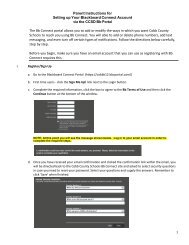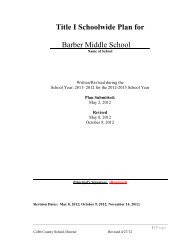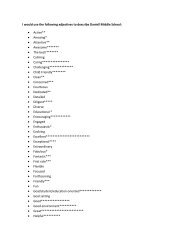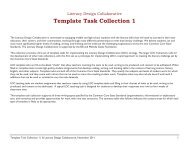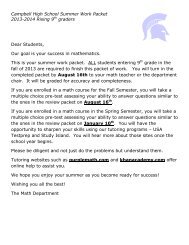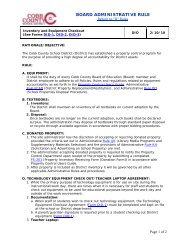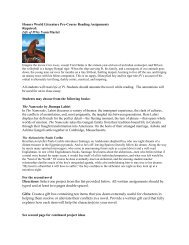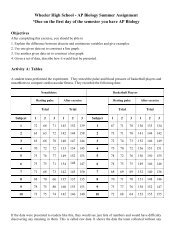Title I Schoolwide Plan for - Cobb County School District
Title I Schoolwide Plan for - Cobb County School District
Title I Schoolwide Plan for - Cobb County School District
You also want an ePaper? Increase the reach of your titles
YUMPU automatically turns print PDFs into web optimized ePapers that Google loves.
<strong>Title</strong> I <strong><strong>School</strong>wide</strong> <strong>Plan</strong> <strong>for</strong>Written/Revised during the<strong>School</strong> Year:August 25, 2011September 6, 2011Principal’s Signature
<strong>Title</strong> I <strong><strong>School</strong>wide</strong> <strong>Plan</strong><strong>Plan</strong>ning Committee Members <strong>for</strong>: <strong><strong>School</strong>wide</strong> <strong>Plan</strong>Date of CommitteeMeeting: September 6, 2011Name of <strong>School</strong>: Fair Oaks ElementaryNAME POSITION/ROLE/PARENT SIGNATURECindy SzwecRonald Craw<strong>for</strong>dGlenda SurrencyMargaret GranthamSonya KennerLori RogersAbigail SpannAileen FernandezKyle EricksonSchona Jones LewisClaudine LisDenise CohenEllen AdamsSherry TrimbleValerie WagleyNancy SmithMarnia LetendreKimberly BoehringerKimberly LeavellDiana RossieVeronica PedrozaMariana CastroPrincipalAssistant PrincipalKindergarten TeacherKindergarten Teacher1 st Grade Teacher2 nd Grade Teacher3 rd Grade Teacher4 th Grade Teacher5 th Grade TeacherSpecial Education TeacherESOL TeacherEIP TeacherMedia SpecialistScience Teacher/EIP TeacherCounselorLiteracy Coach (Primary)Literacy Coach (Intermediate)Math CoachParaprofessionalParent LiaisonParentParent
Table of Contents Pages1. Comprehensive Needs AssessmentA. Participation of Individuals……………………………………………B. Instruments, Procedures, or Processes…………………………………C. The Needs of Homeless, Neglected, and Migrant Children……………D. Current Achievement Data……………………………………………..E. In<strong>for</strong>mation about All Students………………………………………...F. Data, Conclusions………………………………………………………G. Measurable Goals/Benchmarks………………………………………...2. <strong><strong>School</strong>wide</strong> Re<strong>for</strong>m Strategies That Are Scientifically ResearchedA. <strong><strong>School</strong>wide</strong> Re<strong>for</strong>m Strategies That Provide Opportunities For AllChildren………………………………………………………………..………………………………………………..B. Effective Means of Raising Student Achievement…………………….C. Effective Instructional Methods That Increase Learning Time………...D. Address the Needs of All Children……………………………………..363. Instruction by Highly Qualified Professional StaffA. Strategies to Attract Highly Qualified Teachers……………………….B. <strong>School</strong> Status of Highly Qualified Teachers…………………………...4. Professional Development For StaffA. Include Teachers, Principals, Paraprofessionals, and Others…………B. Aligned Professional Development with the State’s AcademicContent…………………………………………………………………C. Professional Development Activities that Address the Root Causes…..D. Include Teachers in Professional Development Activities Regardingthe Use of Academic Assessments……………………………………..E. <strong>School</strong>s Yearly Professional Development Schedule………………….885. Strategies to Increase Parental InvolvementA. Involved Parents in the <strong>Plan</strong>ning of the Comprehensive <strong><strong>School</strong>wide</strong>Program………………………………………………………………...B. Parent Involvement Policy and Parent Compact………………………6. <strong>Plan</strong>s <strong>for</strong> Assisting Preschool Children in the Transition From Early ChildhoodPrograms and/or Students Entering Middle <strong>School</strong> or High <strong>School</strong>…………………. 12117. Measures to Include Teachers in the Decisions Regarding the Use ofAssessment……………………………………………………………………..12
8. Coordination and Integration of Federal, State, and Local Services andProgramsA. List of State and Local Educational Agency Programs and OtherFederal Programs that will be Included………………………………B. Description of How Resources from <strong>Title</strong> I and Other Sources will beUsed……………………………………………………………………C. <strong>Plan</strong> Developed in Coordination with Other Programs………………..9. Activities to Ensure that Students who Experience Difficulty MasteringStandards shall be Provided with Effective , Timely AssistanceA. Measures to Ensure that Students’ Difficulties are Identified on aTimely Basis……………………………………………………………B. Periodic Training <strong>for</strong> Teachers in the Identification of Difficulties……C. Teacher-Parent Conferences……………………………………………131310. Description of how Individual Student Assessment Results will be Providedto Parents………………………………………………………………………. 1411. Provisions <strong>for</strong> the Collection and Disaggregation of data……………………. 1412. Provisions to Ensure the Disaggregated Assessment Results are Valid andReliable…………………………………………………………………………13. Provisions <strong>for</strong> Public Reporting of Disaggregated Data……………………… 1414. <strong>Plan</strong> Developed During a One-Year Period…………………………………... 1415. <strong>Plan</strong> Developed with the Involvement of the Community to be Served……… 1416. <strong>Plan</strong> Available to the LEA, Parents, and the Public…………………………... 1417. <strong>Plan</strong> Translated………………………………………………………………... 1418. <strong>Plan</strong> is Subject to the <strong>School</strong> Improvement Provisions of Section 1116 ……... 1414
1. Comprehensive Needs Assessment of the entire school that addresses all academicareas and other factors that may affect achievement.A. We have developed our schoolwide plan with the participation of individuals who willcarry out the comprehensive schoolwide/school improvement program plan. Thosepersons involved included teachers from each grade level, academic coaches, ESOL,EIP, and special education teachers, school counselors, our media specialist,paraprofessionals, parents and school administrators. This is our “<strong>School</strong>Improvement Team” or SIT. The work of this group is ongoing throughout the schoolyear. They review student achievement data, school improvement survey data, studentservice models and parental involvement activities to determine areas of strength andareas <strong>for</strong> growth.<strong>School</strong> Improvement Team (SIT) Members:Cindy Szwec, PrincipalRonald Craw<strong>for</strong>d, Assistant PrincipalGlenda Surrency, Kindergarten Margaret Grantham, KindergartenSonya Kenner, First Grade Lori Rogers, Second GradeAbigail Spann, Third Grade Aileen Fernandez, Fourth GradeKyle Erickson, Fifth Grade Schona Jones-Lewis, Special EducationEllen Adams, Media Specialist Kimberly Leavell, ParaprofessionalSherry Trimble, Science Specialist Nancy Smith, Academic CoachMarnia Letendre, Academic Coach Kimberly Boehringer, Academic CoachValerie Wagley, Counselor Diana Rossie, Parent LiaisonVeronica Pedroza, ParentMariana Castro, ParentDenise Cohen, Early Intervention ProgramB. We have used the following instruments, procedures, or processes to obtain thisin<strong>for</strong>mation. As a group we review student achievement data throughout the schoolyear to determine the effectiveness of our instructional practices. Specifically weanalyzed data from our Criterion Referenced Competency Test (CRCT), Fifth GradeWriting Assessment, Third Grade Writing Assessment, and our Mock CRCT data <strong>for</strong>1 st and 2 nd grade. We provide surveys to parents following all parental involvementactivities to determine the effectiveness of the event. We also participate in a countyschool improvement survey given to parents, staff, and students each year. The SITmeets monthly to look at schoolwide data related to student achievement, parentalinvolvement, and schoolwide practices. As a group, the SIT, brainstorms ways toimprove in each of these critical areas of needs <strong>for</strong> our school.A review of the schoolwide academic data showed areas of strength in math andEnglish Language Arts across all grade levels. Our students continue to struggle withwriting and with both reading comprehension and reading fluency. A review of thestaff, student and parent surveys indicate a high level of satisfaction with the programs,environment and organization of our school.C. As a highly transient area, we serve homeless, neglected, and/or migrant students.These students are protected by federal laws and are welcomed into our school. They
are provided the same high quality instruction as all other Fair Oaks Students. Whenpossible, homeless students are af<strong>for</strong>ded the opportunity to choose to attend school inthe current school zone where they are living, or to attend their previous school withtransportation provided by the <strong>Cobb</strong> <strong>County</strong> <strong>School</strong> <strong>District</strong>. We have taken intoaccount the needs of homeless, neglected and migrant children by providing a researchbased schoolwide instructional program proven to be effective with children from highpoverty. The America’s Choice Workshop model, implemented consistently, is highlyeffective in all academic areas. Our school is very transient making it essential thatwe provide a welcoming, safe environment <strong>for</strong> all students. We provide after schoolassistance with homework and after school tutoring and clubs to help students feelsuccessful. All students are provided with these opportunities. When a child isidentified as migrant or homeless, our staff makes extra ef<strong>for</strong>ts to provide essentialresources <strong>for</strong> the family including food, clothing and tutoring.D. We have reflected current achievement data that will help the school understand thesubjects and skills in which teaching and learning need to be improved. For exampleour current school data indicates our students’ with disabilities continue to per<strong>for</strong>mbelow other students. As a whole, our students per<strong>for</strong>med very well, exceeding thestate bar set <strong>for</strong> AYP (Adequate Yearly Progress) with 87.7% meeting or exceedingstandards in math and 83.4% meeting or exceeding standards in reading/Englishlanguage arts. Students in the Hispanic, English Language Learner, and EconomicallyDisadvantaged groups per<strong>for</strong>med above the state set academic standard.Georgia Criterion Referenced Competency Test (CRCT)Reading/ ELA Percent Meets & Exceeds2003 2004 2005 2006 2007 2008 2009 2010 2011All 46 64 72 52 64 72 76 84 83Black 46 69 72 48 69 79 72 90 76Hispanic 43 62 69 47 60 70 76 83 85White 69 62 87 88 79 73 87 79 71SWD 14 34 62 35 54 52 49 74 66ELL 14 41 49 25 40 55 70 81 81ED 40 62 70 50 63 72 76 84 83Male 62 79 80Female 77 88 89*2011 Data does not include the calculation with CRCT retest scores.
content standards and the state student academic achievement standard including ourstudents with disabilities group, black student group and white student group. Whilewe do not have enough students in either the black student group or white studentgroup to be counted on our student per<strong>for</strong>mance data, it is important to note theper<strong>for</strong>mance of these groups.Discrepancies exist between the per<strong>for</strong>mance of our general education group and ourstudents with disabilities (SWD) group. The category of “All” students showed 83.4%of students meeting or exceeding standards on the Reading/ELA portion of the CRCTwhile only 66.4% of the SWD group met or exceeded standards. In math there is lessof a discrepancy with 87.7% of “All” students meeting or exceeding standards and83.6% of the SWD group meeting or exceeding standards. We have also noted adiscrepancy between the per<strong>for</strong>mance of our male and female students. Eighty-ninepercent or our fe male students met or exceeded standards on the Reading/ELAportion of the CRCT while only 80% of male students met or exceeded. The trend issimilar in math with 87% of female students meeting or exceeding standards and 83%of male students meeting or exceeding standards. As the annual measurable objectivesincrease <strong>for</strong> the state, we will continue to provide research based instructionalstrategies that prepare our students to meet these goals.F. Students at Fair Oaks participate in the following assessments:National: 3 rd & 5 th Grade Iowa Test of Basic Skills (ITBS)1 st & 3 rd Grade – Cognitive Achievement Test (CogAT)State: Kindergarten –Georgia Kindergarten Inventory of DevelopmentalSkills (GKIDS)3 rd – 5 th Criterion Referenced Competency Test (CRCT)5 th Grade - Georgia 5 th Grade Writing Assessment3 rd Grade Writing AssessmentK-5 ACCESS Testing: Assessing Comprehension and Communicationin English State to State <strong>for</strong> English Language LearnersSpecial Education GAA – Georgia Alternative AssessmentLocal: 1 st – 5 th Grades - <strong>Cobb</strong> <strong>County</strong> Benchmark & Checkpoint TestsK-5 – Diagnostic Reading Assessment (DRA)1 st – 5 th Grades – Mock CRCT, Writing Assessments, TeacherDeveloped AssessmentsAn analysis of local school assessments as well as the Georgia CRCT allowed us todraw the following conclusions regarding student strengths and weaknesses:‣ The major strengthso Math per<strong>for</strong>mance was strong at every grade level. Our studentsper<strong>for</strong>med well in geometry, algebra and numbers and operations.o English Language Arts was strong at all grade levels. Studentsper<strong>for</strong>med well in grammar and sentence construction.o Reading per<strong>for</strong>mance was strong in reading skills and vocabularyacquisition at 3 rd & 5 th grade.
‣ The major areas <strong>for</strong> growtho Reading <strong>for</strong> in<strong>for</strong>mation and reading fluency are areas that needimprovement.o Writing per<strong>for</strong>mance is weak <strong>for</strong> all grade levels. Specifically, narrativewriting and response to literature genres need improvement. Studentwriting pieces show weakness in writing conventions and writingstyle.o A review of data indicates a difference between the academicper<strong>for</strong>mance of boys and girls. Girls out per<strong>for</strong>med boys in readingand English/Language arts at all grade levels.‣ As a staff we will continue to focus on improving student per<strong>for</strong>mance <strong>for</strong> allstudents in each academic area. We will set specific goals <strong>for</strong> reading, writing,math, and student efficacy. We have shown continuous improvement over thelast 4 years. We attribute the improvement to the schoolwide recommitmentto the America’s Choice instructional framework and the departmentalizationof teaching in grades 1-5.G. The measurable goals/benchmarks we have established to address student achievement:Increase percentage of students meeting or exceeding standards on the CRCTin Reading/English Language Arts from 83.4% to 86.7%Increase percentage of students meeting or exceeding standards on the CRCTin Math from 87.8% to 90%Increase percentage of students meeting or exceeding standards on the 5 thGrade Writing Assessment from 68% to 75%2. <strong><strong>School</strong>wide</strong> Re<strong>for</strong>m Strategies that are scientifically researched based.America’s Choice has been the instructional framework at Fair Oaks Elementary <strong>for</strong> more than10 years. Four years ago the school recommitted to the framework as a schoolwide expectation<strong>for</strong> instruction. America’s Choice is not a curriculum; it is instead a tool that supports theGeorgia Per<strong>for</strong>mance Standards, the existing state-mandated curriculum. Developed bythe National Center on Education and the Economy (NCEE) 15 years ago, America’sChoice is a research-based school improvement program that has proven effective <strong>for</strong>many school districts across the nation. With the goal of closing achievement gaps,enhancing teacher quality and sustaining school improvement over time, America’sChoice focuses on providing tailored instruction to struggling students in order to accelerate theirlearning and ultimately, change school culture. To do so, the program aligns standards,instruction, assessments and provides teachers with teaching strategies to help students who arelagging behind in the subjects of reading, writing and mathematics.The America’s Choice <strong>School</strong> Design helps districts and schools focus on five critical elementsof school improvement.1. Creating a standards-based system with assessments that monitor progress andin<strong>for</strong>m instruction
2. Aligning instruction to standards and focusing teaching on moving students fromwhere they are to where they need to be3. Strengthening instructional leadership4. Building professional learning communities5. Engaging parents and the communityIn 2002, Jonathan A. Supovitz, Brooke Snyder Taylor, and Henry May published an articleentitle, Impact of America's Choice on Student Per<strong>for</strong>mance in Duval <strong>County</strong>, Florida. Theirfindings stated, “The America’s Choice Design is a K-12 comprehensive school re<strong>for</strong>m model designedby the National Center on Education and the Economy. America’s Choice focuses on raising academicachievement by providing a rigorous standards-based curriculum and safety net <strong>for</strong> all students. The goalof America’s Choice is to make sure that all but the most severely handicapped students reach aninternationally benchmarked standard of achievement in English/language arts and mathematics by thetime that they graduate. The Consortium <strong>for</strong> Policy Research in Education (CPRE) at the University ofPennsylvania was contracted by the National Center on Education and the Economy (NCEE) to conductthe external evaluation of the America’s Choice <strong>School</strong> Design in 1998. Each year CPRE designs andconducts a series of targeted studies on the implementation and impacts of the America’s Choice design.The report presented here is one of this year’s evaluation reports. The purpose of CPRE’s evaluation is toprovide <strong>for</strong>mative feedback to NCEE and America’s Choice schools about emerging trends in theimplementation of the design, and to seek evidence of the impacts of the design using accepted highstandards of evaluation design and analysis methodologies. Overall, the patterns in student standardizedtest per<strong>for</strong>mance indicate that students in America’s Choice schools regularly outgained students in otherdistrict schools in writing, and to a lesser extent reading and mathematics, after controlling <strong>for</strong> priorstudent achievement, and student and school demographic characteristics. In all three subjects, in bothelementary and middle schools, there were multiple examples of significantly higher learning gains ofstudents in America’s Choice schools in comparison to students in other schools in the district, whilethere were no cases where students in the other district schools statistically outgained students inAmerica’s Choice schools. In many cases, the differences in learning were positive in favor of students inAmerica’s Choice schools, but only approaching statistical significance, in part due to the small numberof America’s Choice schools in some parts of the study. By contrast, there were no cases where studentsin other district schools outgained students in America’s Choice schools that were even approachingstatistical significance. In fact, the only school-level variable that came up significant more often thanAmerica’s Choice was the percentage of students in a school receiving free or reduced-price lunch, anindicator of poverty that has long been documented to be strongly associated with student per<strong>for</strong>mance.”Similarly, 2003 research by Jonathan A. Supovitz and Henry May found a positive relationshipbetween teacher implementation of the America’s Choice instructional model and studentlearning. In Supovitz and May’s article, The Relationship Between Teacher Implementation ofAmerica's Choice and Student Learning in Plainfield, New Jersey, the researchers stated theirresults were an uncommon piece of evidence that empirically links teachers’ implementation ofAmerica’s Choice to student learning. The pattern from these results seems clear and persistent: thestudents of teachers who more deeply implemented the America’s Choice model, particularly the writersworkshop component of the design, learned more than did the students of teachers who had lower levelsof implementation. Even after statistically controlling <strong>for</strong> the background characteristics of teachers andstudents and <strong>for</strong> students’ prior test per<strong>for</strong>mance, teachers’ implementation of America’s Choice wasassociated with significantly higher learning gains <strong>for</strong> students.”A. We will increase the amount and quality of learning by providing high impactinstructional strategies <strong>for</strong> students during the school day as well as providing
after school activities to engage students in remediation, extension andper<strong>for</strong>mance activities.During the <strong>School</strong> Dayo Departmentalization – In 1 st – 5 th grades students receiveinstruction in 2 classrooms each day. One classroom focuses onliteracy including daily guided reading, grammar and skills, as wellas daily writing. The second classroom focuses on math, scienceand social studies. This departmentalization model allows teachersto teach in their area of strength. Teachers are able to plan morethoroughly when planning <strong>for</strong> a reduced number of content areas.We believe that the departmentalization has had a positive impacton student achievement.o Early Intervention Program – Our Early Intervention Program (EIP)teachers “push-in” to the general education classroom. Students areidentified as EIP based on skills checklists completed in K-2 andbased on their per<strong>for</strong>mance on the CRCT <strong>for</strong> students in grades 3-5.Students per<strong>for</strong>ming below level qualify <strong>for</strong> additional instructionduring the school day. The EIP teachers plan with the classroomteachers to provide additional instruction to students in theclassroom during reading, writing, and math.o ESOL Program – Our ESOL teachers also “push-in” to provideadditional instruction to qualified ESOL students during readingand writing. Students qualify <strong>for</strong> ESOL services based on theirscores on the Georgia ACCESS test.o Intensive English Language Program – Our IEL teacher providesbilingual instruction to students with no English languageexperience. She provides instruction to students to develop theirEnglish language skills so that they can receive instruction incontent areas as quickly as possible.o Special Education Program – Our special education teachersprovide services based on the specific needs outlined in eachstudent’s IEP. Services provided at Fair Oaks include inclusion,small group and self-contained programs.After <strong>School</strong> Activitieso Homework Hotspot (Assistance with Homework & Projects)o Math Academy (Extension) & Math Club (Remediation)o Literacy & Technology Clubo Science Olympiado Drama Clubo Origami Clubo Choruso Cheerleadingo Eagle Ambassadors – Leadership Group <strong>for</strong> BoysB. The effective implementation of federal, state, and locally funded programs willaddress the needs of all children. Specifically we will use Reading Recovery,
EIP, ESOL, Guided Reading, CAFÉ Strategies, and Reader’s Workshop toincrease student per<strong>for</strong>mance in reading. To improve student per<strong>for</strong>mance inmath we will use Math Workshop, RAP, EIP, FASTT Math, and Fraction nation.To improve student per<strong>for</strong>mance in writing we will use a daily Writer’sWorkshop, ESOL, EIP and frequent writing prompts. In all content areas we willincrease our use of available technology as a means of engaging students andimproving student per<strong>for</strong>mance. Consistent collaboration and data collection byall teachers will determine if all students are achieving at levels set by the state ofGeorgia and in compliance with improvement plans approved under theElementary and Secondary Education Act of 1965 (ESEA).3. Highly Qualified Professional Staff.We will provide instruction by highly qualified teachers and paraprofessionals whomeet the standards established by the state of Georgia. All staff members at FairOaks are considered highly qualified according to Georgia standards. In order toattract highly qualified teachers, the administrative team at Fair Oaks participates inlocal job fairs and reviews candidate qualifications using the <strong>Cobb</strong> <strong>County</strong> HumanResources STAR applicant system. As a school we host interns from Kennesaw StateUniversity, Mercer University, Georgia State University, University of Georgia, andSpellman College as well as students from a variety of online universities. Webelieve that providing field experiences <strong>for</strong> these preservice teachers allows us to seetheir per<strong>for</strong>mance with our students and select those people who will be a valuableasset to our school.4. Professional development <strong>for</strong> staff to enable all children in the schoolWe have included teachers, administrators, and paraprofessionals in our staffdevelopment that addresses the root causes of our identified needs. This year wewill partner with other schools in our area to provide professional developmentspecifically focused on engaging students from high poverty communities. Thisprofessional development will be provided by Eric Jensen, author of Teachingwith Poverty in Mind.We have aligned professional development with the State’s academic content andstudent academic achievement standards. We will provide professionaldevelopment in the areas of:Georgia Per<strong>for</strong>mance Common Core Curriculum StandardsIntegrating Writing Across Content AreasImproving Student Writing Through Guided Writing InstructionImproving Reading Fluency <strong>for</strong> All StudentsImproving Number Sense and Critical Thinking in MathInstructional Strategies to Improve Achievement of Boys
We have devoted sufficient resources to carry out effectively the professionaldevelopment activities that address the root causes of academic problems.Resources <strong>for</strong> professional development include:Local <strong>School</strong> Academic Coaches <strong>for</strong> Literacy and Math<strong>County</strong> Personnel – Professional Learning Supervisors, <strong>County</strong> LiteracyCoaches<strong>County</strong> Funded Professional Development Courses<strong>County</strong> Provided <strong>School</strong> Focused Professional Learning Funds<strong>Title</strong> II Grant MoneyLocal <strong>School</strong> Instructional FundsWe have included teachers in professional development activities regarding theuse of academic assessments to enable them to provide in<strong>for</strong>mation on, and toimprove, the achievement of individual students and the overall instructionalprogram in the following ways:SIT Retreat to review academic per<strong>for</strong>mance data and identify areas ofstrengths and weaknessesWeekly team meeting discussions regarding grade level assessmentsFollowing schoolwide assessments, action plans are written <strong>for</strong> studentsidentified as per<strong>for</strong>ming below level.Data Team Meetings to review student progress and discuss strategies toassist struggling students.
2011-2012 Professional Development For:KeyAll StaffLiteracy TeachersMath TeachersFair Oaks Elementary2011-2012 Proposed Professional LearningMonth Core Area Addressed GradeLevelCostAugust Tuning Protocol Training K-5 0September Grade Level Data TeamMeetings: Assessment ofStudent Learning,Collaboration and <strong>Plan</strong>ningProposed Funding SourceK-5 $1,800 <strong>School</strong> FocusedProfessional LearningFundsSeptember Literacy: Lester Laminack K-5 $7,875 <strong>Title</strong> II GrantSeptember Math: Kathy Richardson K-5 $7,875 <strong>Title</strong> I FundsSeptember/OctoberOctoberOctoberOctoberOctoberOctober/NovemberNovemberNovemberNovemberLiteracy Webinar: TannyMcGregor – ComprehensionConnections: Bridges toStrategic ReadingGCTM Georgia Council ofTeachers of MathematicsConferenceLiteracy: Lucy Calkins – Unitsof Study in Reading – AtlantaConferenceEric Jensen: Teaching withPoverty In MindePD Coaching: INFORMativeAssessmentLiteracy Webinar: Fountas &Pinnell – Reading in SmallGroupsAuthentic AssessmentPractices to Enhance StudentLearning in Physical EducationLiteracy Webinar: Fountas &Pinnell – Guided Reading:Good 1 st Strategies <strong>for</strong> AllchildrenePD: Common Sense and theCCSS3-5OptionalAfter<strong>School</strong>6Teachers$219 <strong>School</strong> FocusedProfessional LearningFunds$1,000 <strong>Title</strong> I Funds3-5 $2,865 <strong>Title</strong> I FundsK-5 $9,100 <strong>Title</strong> I FundsK-5OptionalAfter<strong>School</strong>3-5OptionalAfter<strong>School</strong>$108 <strong>School</strong> FocusedProfessional LearningFunds$219 <strong>School</strong> FocusedProfessional LearningFunds2 People $450 <strong>School</strong> FocusedProfessional LearningFundsK-2OptionalAfter<strong>School</strong>K-5OptionalAfter<strong>School</strong>$219 <strong>School</strong> FocusedProfessional LearningFunds<strong>School</strong> FocusedProfessional LearningFunds
November Barbara Novelli: Strategies <strong>for</strong> K-5 $9,300 <strong>Title</strong> II GrantTeaching Reading and WritingAcross the Curriculum –Improving Reading, Writing, &ThinkingNovember Kindergarten Conference K $2,952 <strong>Title</strong> II GrantDecember Number Talks Training: K-5 $7,875 <strong>Title</strong> I FundsDecemberMental Math & ComputationGrade Level Data TeamMeetings: Assessment ofStudent Learning,Collaboration and <strong>Plan</strong>ningK-5 $1,800 <strong>School</strong> FocusedProfessional LearningFundsJanuary National <strong>Title</strong> I Conference 6 People TBD <strong>Title</strong> I FundsFebruary Literacy: Creating Fluent 9 People $1,800 <strong>Title</strong> II GrantReaders Conference - AtlantaFebruaryMath: Marcy Cook K-5 <strong>Title</strong> I FundsIncreasing Critical ThinkingMarchGrade Level Data TeamMeetings: Assessment ofStudent Learning,Collaboration and <strong>Plan</strong>ningK-5 $1,800 <strong>School</strong> FocusedProfessional LearningFundsAprilAprilMayTBDGreg TangIncreasing Thinking in MathReview of State Webinars <strong>for</strong>Common Core CurriculumStandardsReview of State Webinars <strong>for</strong>Common Core CurriculumStandardsKathleen Cleveland: TeachingBoys Who StruggleK-5 $3,000 <strong>Title</strong> I FundsK-5 $1,800 <strong>School</strong> FocusedProfessional LearningFundsK-5 $0 Post <strong>Plan</strong>ning – No FundsRequiredK-5 TBD <strong>Title</strong> I Funds5. Strategies to increase parental involvementA. We have involved parents in the planning, review, and improvement of thecomprehensive schoolwide program plan by including them in the planningmeetings <strong>for</strong> the writing of the plan as well as providing schoolwide plan drafts toparents in the parent resource center.B. We have developed a parent involvement policy included in our appendices that‣ Includes strategies to increase parental involvemento Increasing Parents’ Understanding of Math Workshop• Helping Children with Math Fluencyo Home Literacy Activities to Improve Student Per<strong>for</strong>mance inReading.• Helping Children Improve Reading Comprehension andFluency
o Supporting Parents of Students with Disabilities• Understanding Parental Rights Related to Special Education• Understanding Individual Education <strong>Plan</strong>s (IEP)o CRCT Parent Meetings• Overview of test as well as a review of test preparationmaterials available <strong>for</strong> parents to help students at home.o Curriculum Nights• Literacy Night: Students and parents were provided withliteracy activities that addressed standards appropriate <strong>for</strong>their grade level.• Math, Science & P.E Night: Students and parents wereengaged in math problem solving activities as well as scienceexperiments and physical fitness activities.• Grade Level “Make & Take” Nights <strong>for</strong> parents to makeeducational games that they can take home to play with theirchildren.‣ Individual student academic assessment results are provided to parentsthrough weekly reports, parent conferences, and parent meetings. Parentsare provided with both face to face and written explanations of studentassessments and student results.‣ The schoolwide <strong>Title</strong> I Program <strong>Plan</strong> is available on the school website,school media center, and the school parent resource center. The plan isavailable in the media center and parent resource center in both English andSpanish.6. Transition <strong>Plan</strong>s:<strong>Plan</strong>s <strong>for</strong> assisting preschool children in the transition from earlychildhood programs to local elementary school programs and/or students enteringmiddle school or high school‣ Local preschools and childcare centers are invited to bring rising kindergartenstudents <strong>for</strong> a tour of our school including classroom visits and a snack in thecafeteria. “Kindergarten Camp” is a two week program in June provided <strong>for</strong>incoming kindergarten students. During this “camp” students learn schoolroutines as well as explore beginning literacy and math skills. Staff membersfrom Griffin Middle <strong>School</strong> come to Fair Oaks to share in<strong>for</strong>mation abouttransitioning to middle school. They meet with students in early May. TheGriffin staff also holds Town Hall Meetings twice during the year at Fair Oaks toshare in<strong>for</strong>mation about the school and assist parents with questions and concernsabout middle school.7. Measures to include teachers in the decisions regarding the use of assessment toprovide in<strong>for</strong>mation on, and to improve, the per<strong>for</strong>mance of individual students andthe overall instructional program.‣ A schoolwide assessment plan is written each year to include national, state,county and local assessments. Teachers provide input to the <strong>School</strong> Improvementteam regarding which local assessments are most valuable, when the assessmentsshould be given, and how the data from the assessment should be used to
determine student progress. The <strong>School</strong> Improvement team develops theassessment plan based on teacher input and insures that it aligns to the specificstudent achievement goals in the school strategic plan.8. Coordination and integration of Federal, State, and local services and programsFair Oaks will use all federal, state, and local resources to provide an instructionalprogram that meets the needs of all students. We will continue to bedepartmentalized in grades 1-5, allowing teachers to specialize their planning andinstruction. Special education services will be provided in a continuum of services toall students qualifying <strong>for</strong> special education. The Georgia funded Early InterventionProgram and ESOL programs will be implemented to provide additional instruction<strong>for</strong> students per<strong>for</strong>ming below grade level and English Language Learners.A. Description of how resources from <strong>Title</strong> I and other sources will be used.Resources from <strong>Title</strong> I combined with federal, state, and local resources will becoordinated to create a high quality instructional environment focused on meetingschool strategic plan goals and meeting academic goals set by the state.Coordination of Resources <strong>for</strong> Professional LearningLocal <strong>School</strong> Academic Coaches <strong>for</strong> Literacy and Math<strong>County</strong> Personnel – Professional Learning Supervisors, <strong>County</strong>Literacy Coaches<strong>County</strong> Funded Professional Development Courses<strong>County</strong> Provided <strong>School</strong> Focused Professional Learning Funds<strong>Title</strong> II Grant MoneyLocal <strong>School</strong> Instructional FundsCoordination of Resources <strong>for</strong> Instructional SupportEarly Intervention ProgramESOL ProgramIntensive English Language ProgramSpecial Education ProgramResponse to Intervention9. Activities to ensure that students who experience difficulty mastering standardsshall be provided with effective, timely assistance, which shall include:‣ Consistent data team meetings and effective implementation of the Response toIntervention model will ensure that students who experience difficulty masteringproficient or advanced levels of academic achievement standards shall beidentified on a timely basis. Frequent collaboration and data monitoring willidentify students and ensure that they receive effective, timely additionalassistance. Additional services are provided during the school day through theEarly Intervention Program, ESOL program, Intensive English Language Program(IEL), and special education program. After school, students receive remediationand extension through math, literacy, technology and per<strong>for</strong>mance clubs.Each year teachers receive training in identifying students per<strong>for</strong>ming on, above,and below level. They receive training in using the Academic Portal data
warehouse provided by <strong>Cobb</strong> <strong>County</strong>. Frequent collaboration and support fromacademic coaches allow teachers to identify struggling students and appropriateassistance <strong>for</strong> these students.Teachers meet with parents of all students a minimum of one time per year.Parents of students that are struggling meet with the teacher more frequently. Atthese teacher-parent conferences, parents receive details of what the school willdo to help the student, what the parents can do to help the student, as well asadditional assistance available to the student at the school or in the community.10. Parents are invited to attend conferences throughout the school year. At theseconferences parents receive the results and an explanation of local, state, and nationalassessments. Teachers explain the student’s per<strong>for</strong>mance in relation to other students inGeorgia and the nation. Teachers also provide in<strong>for</strong>mation to parents about studentper<strong>for</strong>mance on county and teacher made assessments. Parents receive the results ofclassroom assessments through weekly folders, parent conferences and parent workshops.11. Teachers collaborate during data team meetings to discuss student achievement as well asinstructional practices to move students <strong>for</strong>ward. A schoolwide data wall is used tomonitor student progress. Student data cards are placed on the wall based on studentper<strong>for</strong>mance in reading and math. Student cards are placed on the wall based onper<strong>for</strong>mance that is above, on, or below standards. These data cards are updated each 9weeks.Through an electronic data warehouse schools have access to student and schoolwidedata. Teachers can access student assessment in<strong>for</strong>mation through AssessTrax. Thisincludes national and state assessments as well as county wide assessment data. <strong>School</strong>administrators have access to schoolwide data through FETCH. This data sourceprovides in<strong>for</strong>mation to administrators about individual student per<strong>for</strong>mance, classroomper<strong>for</strong>mance as well as overall school per<strong>for</strong>mance.12. Disaggregated assessment results <strong>for</strong> state and national tests are provided by the testingcompany. Local school assessment results are disaggregated during data team meetings.All assessment results are reviewed based on grade level results then by student groupsincluding SWD, ELL, and ethnicity. Data is also reviewed according to services studentsreceive during the school day including special education, EIP, ESOL, and ALP(Advanced Learning Program). A thorough review of student data will determine ifassessments were valid and reliable. When the assessment measures its intendedpurpose, student results will show consistent per<strong>for</strong>mance between assessments.13. Student data results from national and state assessments are made available through theschool district communications office. We also provide results of state and localassessments to the public via PTA meetings, school council meetings, our school website,parent resource center, newsletter, and school strategic plan.
14. Our schoolwide plan is developed <strong>for</strong> a one-year period. It is reviewed by teachers,administrators and parents and revised as needed based upon student achievement results,local school surveys, and school strategic plan goals.15. Our schoolwide plan is developed based on feedback and involvement of our schoolcommunity, teachers, classified staff members, and administrators. The following peoplewere directly involved in the development of the schoolwide plan:Cindy Szwec, PrincipalRonald Craw<strong>for</strong>d, Assistant PrincipalGlenda Surrency, Kindergarten Margaret Grantham, KindergartenSonya Kenner, First Grade Lori Rogers, Second GradeAbigail Spann, Third Grade Aileen Fernandez, Fourth GradeKyle Erickson, Fifth Grade Schona Jones-Lewis, Special EducationEllen Adams, Media Specialist Kimberly Leavell, ParaprofessionalSherry Trimble, Science Specialist Nancy Smith, Academic CoachMarnia Letendre, Academic Coach Kimberly Boehringer, Academic CoachValerie Wagley, Counselor Diana Rossie, Parent LiaisonVeronica Pedroza, ParentMariana Castro, ParentDenise Cohen, Early Intervention Program16. Our schoolwide <strong>Title</strong> I plan, Parent Involvement <strong>Plan</strong> and <strong>School</strong> Strategic <strong>Plan</strong> areavailable to the LEA, parents, and the public on our school website, in our media center,and parent resource center.17. Our schoolwide plan is translated into Spanish. Translations into other languages areavailable upon request.18. The Fair Oaks <strong><strong>School</strong>wide</strong> <strong>Title</strong> I <strong>Plan</strong> is subject to the school improvement provisions ofSection 1116. Our plan is based on assessments and strategies to help students meet andexceed the academic standards and annual measurable objectives set by the state. Our<strong>School</strong> Improvement Team (SIT) is a shared governance model that is used tocommunicate ideas and plan <strong>for</strong> improvement. This team oversees the development andimplementation of our <strong><strong>School</strong>wide</strong> <strong>Title</strong> I <strong>Plan</strong> and our <strong>School</strong> Strategic <strong>Plan</strong>. These arecomplementary plans that are living documents that focus on improving academic andschool per<strong>for</strong>mance.
TEACHER/PARENT/STUDENT COMPACT2011-2012SCHOOL MISSISON: The mission of Fair Oaks Elementary <strong>School</strong> is to provide an educational environment conductive tolearning and responsive to the uniqueness of every learner, enabling every learner to have a successful experience towardbecoming responsive, productive, caring citizens and lifelong learners.TEACHER AGREEMENT – I believe that each child can be successful and I commit to:Believe that each child can learn.Show respect <strong>for</strong> each student and his/her family.En<strong>for</strong>ce school and classroom rules fairly.Demonstrate professional behavior and a positive attitude.Come to class prepared to teach.Seek ways to involve parents in the school program.Teacher Signature _______________________________ Date _______________________STUDENT AGREEMENT – I believe that I can be successful and I commit to:Attend school regularly and on time.Arrive prepared and ready to actively participate in daily lessons.Show respect <strong>for</strong> myself, my school and other people.Believe that I can and will learn.Obey the school and bus rules.Always try to do my best in my work and in my behavior.Work cooperatively with my classmates, teachers and other school staff.Student Signature ______________________________ Date ________________________PARENT AGREEMENT- I believe that my child can be successful and I commit to:See that my child attends school regularly and is present in the classroom by 7:45 a.m..Communicate with my child’s teacher on a regular basis.Support the school in developing and demonstrating positive behaviors.Provide a home environment that rein<strong>for</strong>ces further educational development.Monitor television and video game times.Provide time and support <strong>for</strong> homework daily.Stay aware of what my child is learning.Parent/Guardian Signature ______________________ Date ________________________ADMINISTRATIVE TEAM AGREEMENT- I believe Fair Oaks Elementary <strong>School</strong> will continue to be successful. Wewill:Provide an environment that allows <strong>for</strong> positive communication between the teacher, parent and student.Support the teachers in providing high quality instructions.Provide a safe and orderly environment conductive to learning.Provide a welcoming environment <strong>for</strong> students, parents, community members, and staff.Encourage students, their families and staff to keep this compact.Principal Signature ____________________________ Date ________________________
PACTO ENTRE PADRES/MAESTRO/ESTUDIANTE2011-2012MISION DE LA ESCUELA: La misión de la Escuela Primaria Fair Oaks es proporcionar un ambiente educativo queconduzca al aprendizaje y responsabilizarse de que cada alumno tenga una experiencia exitosa para convertirse en ciudadanoscon capacidad de respuesta, responsables, productivos y estudiosos durante toda su vida.COMPROMISO DEL MAESTRO – Yo creo que cada niño puede ser exitoso y me comprometo a:Creer que cualquier niño puede aprenderMostrar respeto a cada estudiante y su familiaAplicar justamente las reglas de la escuela y del salón de clasesMostrar una conducta profesional y una actitud positivaVenir a la clase preparado para enseñarBuscar maneras para incluir a los padres en los programas de la escuelaFirma del Maestro _______________________________ Fecha _______________________COMPROMISO DEL ESTUDIANTE – Yo creo que yo puedo ser exitoso y me comprometo a :Asistir a la escuela con regularidad y a tiempo.Llegar preparado y listo para participar de las lecciones.Mostrar respeto hacia mi mismo, mi escuela y otras personas.Creo que puedo y que voy a aprender.Obedecer las reglas de la escuela y del transporte escolarSiempre tratar de dar lo mejor de mí en mis trabajos y en mi conducta.Trabajar en cooperación con mis compañeros de clase, maestros y el resto del personal de la escuela.Firma del Estudiante ______________________________ Fecha ________________________COMPROMISO DE LOS PADRES- Yo creo que mi hijo puede ser exitoso y me comprometo a:Ver que mi hijo asista a la escuela regularmente y este presente en el salón de clases a las 7:45 a.m.Comunicarme regularmente con el maestro de mi hijo/a.Apoyar a la escuela en el desarrollo y la demostración de conductas positivas.Proporcionar un ambiente familiar que refuerce aun más el desarrollo educativo.Proporcionar tiempo y ayuda en las tareas escolares diariamente.Monitorear el tiempo que mi hijo/a ve la televisión y juega con los juegos de video.Mantenerme al tanto de lo que mi hijo/a esta aprendiendo en la escuela.Firma del Padre/Representante ______________________ Fecha ________________________ACUERDO DEL EQUIPO ADMINISTRATIVO- Yo creo que la escuela Fair Oaks continuara siendo exitosa como hastaahora y nos comprometemos a:Proveer un ambiente que permita una comunicación positiva entre los maestros, padres y estudiantes.Brindar a poyo a los maestros para que ellos a su vez brinden una instrucción de alta calidad a los estudiantes.Proveer un medio ambiente seguro y de orden que nos conducirá al aprendizaje.Proveer un ambiente de bienvenida para los estudiantes, padres, miembros de la comunidad y el personal de estaescuela.Animar a nuestros estudiantes, sus familias y a los miembros de esta escuela a cumplir con este compromiso.Firma de la Directora ____________________________ Fecha ________________________




